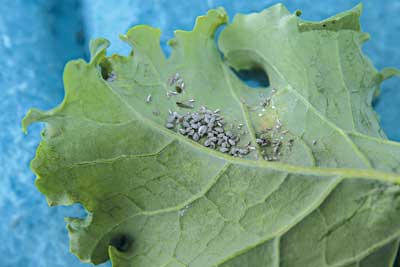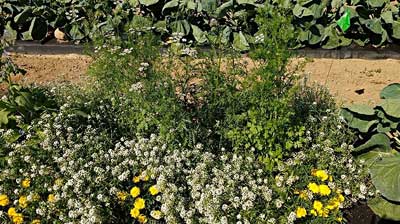 |
| Cabbage aphids on kale growing in a tunnel. Photo by Eric Sideman |
 |
| Habitat plants flowering among brussels sprouts. Photo by Becky Sideman |
By Eric Sideman, Ph.D.
Although it may seem so, the cabbage aphid is not a new pest. My favorite discussion of this pest is in a 1928 text called “Destructive and Useful Insects, Their Habits and Control,” by C.L. Metcalf and W.P. Flint. Even though it was considered a destructive pest back then, to me it seems like the destruction has vastly increased in the past few decades. If you have not seen this pest yet, get ready. The severe damage is on fall crops, but successful management depends on continued vigilance all season, starting in spring. The crops attacked include cabbage, brussels sprouts, kale, cauliflower, as well as wild mustard and shepherd’s purse.
Aphids are small, soft bodied insects that feed by stabbing their hollow, sharply pointed mouthparts through the epidermis of the plant and then sucking the juices out of the cells. Aphids are so tiny that you do not notice them unless you are searching for them. What catches the grower’s eye is a wrinkled, sick looking plant. If you see that, then search in all the crevices and undersides of the leaves. Cabbage aphids tend to cluster even more than do other species of aphids, often making piles of themselves (see photo).
Badly infested plants may turn yellow and even wilt. To make matters worse, aphids excrete their waste as a material kindly referred to as “honeydew” – a dark, gummy liquid that not only serves as a good medium for mold growth but in itself is unsightly. That honeydew and the aphids hiding in crevices and even under the wrappings of brussels sprouts greatly reduce the appeal and marketability of crops.
As with most pests, understanding the biology and where and how the pest lives and reproduces are the keys to management. The first step is finding where and when you can reduce the population with some cultural practice, and when in the life history the pest is most susceptible to a pesticide in case you need to turn to that last resort.
Life History
The life history of aphids is particularly complicated. Typically aphids pass the winter as fertilized eggs on leaves of perennial plants or crop debris. Eggs hatch in early spring. These first nymphs that hatch out of the overwintered eggs are called “stem mothers” because each of them may end up starting a great colony of aphids. All of these stem mothers are female and have a remarkable ability to reproduce without mating. Their vast numbers of offspring are born live – that is, already hatched from the egg (ovoviviparously). These new aphids also can produce young without mating, and also ovoviviparously. Reproduction can commence when the aphids are only a week or so old. A vast number of aphids may arise quickly, and they all cluster around the original stem mother so that patches of the plant may be covered.
At some point, possibly because the food becomes unsatisfactory or for some other reason, some of these females develop wings. These winged aphids fly to new plants and start a new colony in the same fashion as above: without mating and with young being born ovoviviparously.
As the days shorten in fall, a new kind of generation of winged aphids arises, made up of both males and females. These are called fall migrants. They may fly off and find new plants, and their offspring can mate. These females lay eggs that can overwinter.
Interestingly, farther south cabbage aphids can overwinter as active adults and can continue to reproduce ovoviviparously. I believe this is happening in the north now in tunnels where kale and its relatives are grown all winter.
Managing the Pest
Natural management of the size of the population of cabbage aphids is prevalent. This may be hard to believe when you encounter masses of aphids on your crops, but many natural enemies will eat those aphids. The most common are braconid wasps, which lay their eggs in the aphid, and then the larval wasp consumes the aphid from the inside out. Lady beetles are common parasites munching away as they patrol the fields. Syrphid flies lay eggs near aphid colonies, and their larvae crawl along and consume aphids in large numbers. There is lots of help out there, but aphids also have amazing reproductive potential, and which way the battle goes is always a tossup. Anything you can do to favor the predators and parasitoids should be good.
Research at UNH
Talia Levy, an undergraduate student at the University of New Hampshire, works as a summer field technician for Dr. Becky Sideman, the UNH vegetable specialist. While collecting data in some of Sideman’s brussels sprouts variety trials (see “Brussels Sprouts Variety Trial and Topping Study, 2013 & 2014” at https://extension.unh.edu/resources/files/Resource003914_Rep5563.pdf), Levy noted the mass of cabbage aphids on some plants. She was taking an integrated pest management course with Dr. Alan Eaton at the time, so her mental wheels started to turn. With the help of Eaton and Sideman, she designed an experiment to test some management techniques, especially using plants that attracted and supported predators and parasitoids.
Levy set up replicated plots, including plots where nothing was done to control the cabbage aphid, plots with attractive flowers (habitat plants where predators and parasitoids could land and feed on pollen when no aphids where present), and plots treated with some organically approved insecticides.
In her results, the plots with habitat plants did not have significantly different aphid populations than control plots, although the data did show that the flowers attracted more insect enemies of aphids, notably parasitic wasps and syrphid flies, that were destroying lots of aphids, so more research may be needed regarding this aspect of the experiment. Alyssum, cilantro and phacelia attracted the largest number of beneficials, and alyssum attracted the most syrphid flies.
Levy’s work did show that organic pesticides can work very well. Aphids were controlled well by rotating two insecticides, Azera and M-pede. Azera contains two active ingredients: azadirachtin (extracted from neem seeds) and pyrethrins; M-pede is an insecticidal soap. Levy monitored the aphid level by scouting once a week and sprayed only when threshold levels were reached, based on the University of California report at https://ipm.ucanr.edu/PMG/r108300811.html. Email me if you would like to see Levy’s research report.
Cultural Management
Of course cultural practices should be the first line of defense. Since the cabbage aphid overwinters as an egg on the crop, crop rotation is very important. Do not plant a host crop in the same field where one grew the year before. Furthermore, burying the crop debris will bury the overwintering eggs. If you have a winter tunnel with host crops, be sure to destroy those before the aphids can spread to your spring planted field crops. Manage host weeds, especially perennial or winter annual weeds that may harbor overwintering eggs. During the growing season, destroy host crops when harvest is done so that they do not become a harbor for the pest. Most important, keep your eyes open all season, watch small clusters of cabbage aphids, and be ready if a population explosion occurs in late summer.
Eric is MOFGA’s organic crops specialist. You can contact him with your questions at 207-568-4142 or [email protected].
Top
